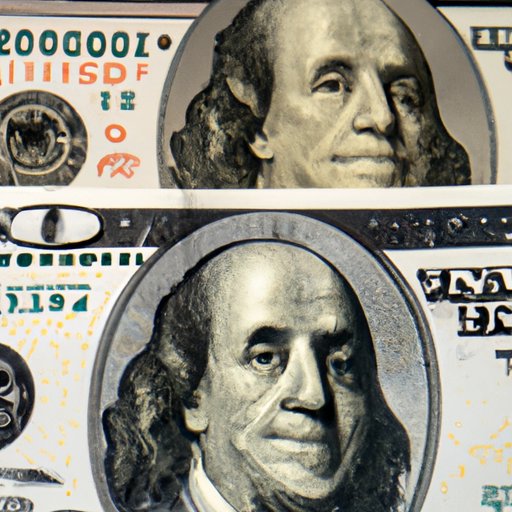
Introduction
Countless people have encountered a problem where they are handed a 100 dollar bill, only to realize it may be fake. Fortunately, there are ways to identify genuine bills from the fakes. The purpose of this article is to help readers learn how to distinguish real from counterfeit 100 dollar bills.
Physical Features That Distinguish Real vs. Fake Bills
One way to spot a counterfeit bill is by looking for physical features that are unique to genuine bills:
- Watermarks: Look for a watermark on the right side of the bill with a faint image of Benjamin Franklin.
- Color-shifting ink: The ‘100’ on the lower right-hand corner of the front of the note has a color-shifting ink that alternates between green and copper when tilted.
- Microprinting: There is microprinting around the portrait of Benjamin Franklin and the phrase “The United States of America” on the front of the bill.
- Security threads: Look for a thin vertical strip with “USA 100” and a small flag that appears pink when held up to the light.
- Detailed images and descriptions: Examine the bill for minute details, including the texture of the ink and the sharpness and clarity of engraving.
Use a Black Light
Another way to detect a counterfeit 100 dollar bill is to use a black light. Here’s how to examine security features using a black light:
- Security thread: A genuine bill has a security thread that will glow pink under a black light. You should see the letters USA and the denomination of the bill ($100) running vertically across the thread.
- Blue security fibers: The bill includes small blue fibers throughout the paper. When put under a black light, the fibers should appear pink.
- Watermark portraits: Hold the bill up to a black light and look for a faint image of Benjamin Franklin, which should appear on both sides of the bill.
Common Counterfeit Methods
While there are many ways to counterfeit a bill, here are the most common methods:
- Color photocopies: Counterfeiters may try to use a high quality color photocopier to copy the image of currency onto a blank piece of paper.
- Inkjet or laser printers: Counterfeiters will use digital printers to produce high-quality bills that are difficult to tell apart from the real thing.
- Altering real bills: Another common method is to bleach the ink off low-denomination bills and reprint them as higher-denomination bills.
- Signs of forgery to look for: Look for details such as blurred or misaligned lines, poor printing quality, and issues with the size and texture of the bill.
Importance of Touch
While it may not be immediately noticeable, touching the bill and feeling the raised texture of the ink can help tell the difference between a genuine and counterfeit bill. As an example, you can rub your finger over the jacket of Benjamin Franklin, and you should feel that texture on genuine bills.
Comparison Test
If you are still unsure whether a suspect bill is counterfeit or real, try using a comparison test. Compare the suspect bill to a known genuine bill of the same denomination, looking for discrepancies in manifesting features. Things like the weight, texture, and paper quality between the two bills will help determine whether a bill is real or fake.
Resources to Report Counterfeit Bills
If you suspect a bill is counterfeit, do not accept it and do not attempt to pass it on to anyone else. Take the counterfeit bill to your nearest police station or bank. You can also contact the United States Secret Service and submit a report by phone (1-800-689-9799), text (202-379-4761), or email (sscoac@usss.dhs.gov).
Conclusion
Distinguishing real bills from counterfeit ones takes only a few seconds of inspection, but it can save you and others from being ripped off. We hope this guide has helped you learn how to identify a real 100 dollar bill, and what to do if you encounter a fake one. Please do not hesitate to seek assistance from authorities or cash handling professionals if you ever receive a bill that appears to be counterfeit.




